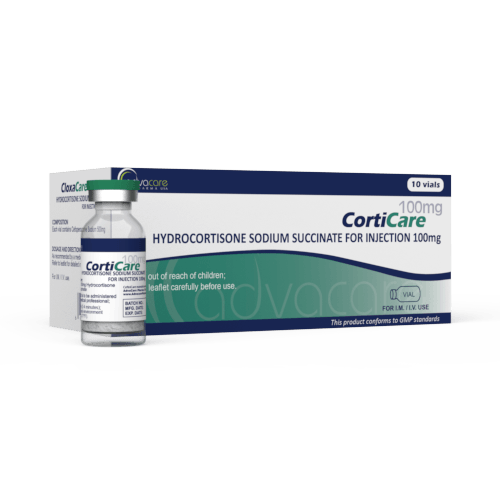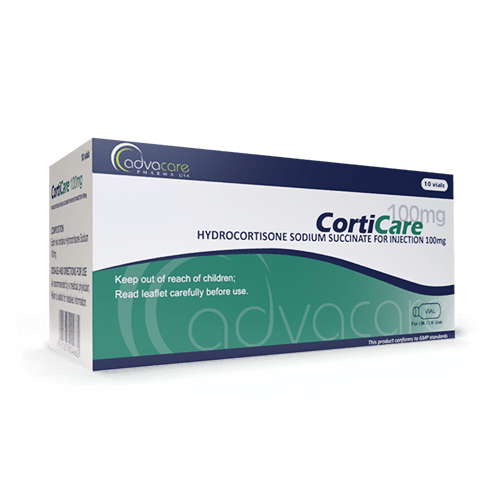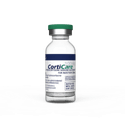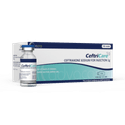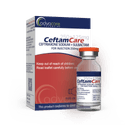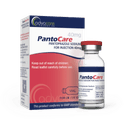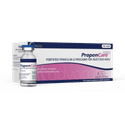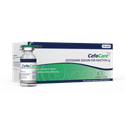- Home›
- Pharmaceuticals›
- Injections›
- Powder for Injection›
- Hydrocortisone Sodium Succinate for Injection
Hydrocortisone Sodium Succinate for Injection
Dosage
Packaging
What is Hydrocortisone Sodium Succinate?
Active Ingredients: Hydrocortisone Sodium Succinate
Hydrocortisone Sodium Succinate for Injection is a steroid drug used to treat skin conditions, asthma, and lung conditions. It is also used to prevent allergic reactions or symptoms caused by autoimmune diseases. This medication helps by relieving symptoms of itching, redness, and swelling.
Hydrocortisone Sodium Succinate is also used during cancer treatment, such as the treatment of leukemia, lymphoma, and multiple myeloma.
Hydrocortisone Sodium Succinate is classified as a corticosteroid, which is readily absorbed from the gastrointestinal tract. Naturally occurring glucocorticoids (hydrocortisone and cortisone) have salt-retaining properties and can be used as replacement therapy in adrenocortical deficiency states. These glucocorticoids have anti-inflammatory effects in disorders of many organ systems.
Hydrocortisone sodium succinate has the same metabolic and anti-inflammatory properties as hydrocortisone. When administered parenterally in equimolar quantities, this drug has equivalent biological activity. The highly water-soluble sodium succinate ester of hydrocortisone enables the rapid intravenous administration of high doses in a small diluent volume. This is beneficial when rapidly elevated blood levels of hydrocortisone are necessary.
The effects of hydrocortisone sodium succinate become evident within an hour after administration and persist for a variable duration. Complete excretion occurs within 12 hours. To maintain sustained high blood levels, injections should be administered every 4 to 6 hours. This drug can lead to significant and diverse metabolic effects while also modulating the body's immune response to various stimuli.
Hydrocortisone is also available as an injection.
AdvaCare Pharma is a trusted global exporter of Hydrocortisone Sodium Succinate for Injection. This drug meets all requirements for GMP certification. It has been manufactured in our facilities in China, India, and the USA.
Why choose us as your Hydrocortisone manufacturer?
AdvaCare Pharma, a US-owned pharmaceutical company, is a Hydrocortisone for Injection manufacturer with GMP-compliant facilities located worldwide. We conduct periodic internal and third-party facility inspections to ensure that our products meet or surpass the requirements of our distributors. Our global reach, as a reliable Hydrocortisone manufacturer, extends to over 65 markets where we supply a wide range of products to our partners, including distributors, hospitals, pharmacies, NGOs, and government institutions.
Uses
What is Hydrocortisone Sodium Succinate used for?
It is used to treat inflammation and prevent allergic reactions in the treatment of autoimmune diseases, skin conditions, asthma and other lung conditions.
How is Hydrocortisone Sodium Succinate for Injection used?
This medication is manufactured as a powder, which is packaged in a vial. After reconstitution, the administration of this injection can be either intravenous or intramuscular. It can also be given through intravenous infusion.
What dose should be given?
Adult Dosing The usual dose for adults is 100-500mg injected intravenously. This dose may be repeated at intervals of 2, 4, or 6 hours.
High doses of this drug can be continued only when the patient is not yet stabilized, and only for 48-72 hours. In cases of continuation of the treatment after 72 hours, hypernatremia might occur.
Pediatric Dosing The recommended dosing for pediatric patients is 0.56- 8mg/kg/day in three or four divided doses (20 to 240 mg/m² BSA/day).
The exact dosage is based on the severity of the condition, age, gender, and weight. Refer to a doctor or pharmacist for guidelines on dosage.
Who can use Hydrocortisone Sodium Succinate?
This drug can be used for relieving allergic states like asthma but is also used for dermatologic diseases, endocrine disorders, gastrointestinal diseases, hematologic disorders, neoplastic diseases, and nervous system disorders. Ophthalmic, renal, and rheumatic disorders can also be treated with this drug.
Special caution should be considered when treating certain groups of patients:
Pregnant This injection can lead to an increased incidence of cleft palate in the offspring. There are not many well-controlled studies performed on pregnant women, so this product should be used with caution and only when the benefits outweigh the risks. Infants of pregnant women who received corticosteroids should be observed for signs of hypoadrenalism.
Nursing This medication can be found in the milk and can suppress the growth of the infant. A healthcare professional should decide whether the mother is an eligible candidate for this medication.
Pediatric Pediatric patients that are treated with hydrocortisone sodium succinate need to be carefully observed. This includes blood pressure measurement, weight, height, intraocular pressure, and a clinical evaluation of possible infections. This medication might also lead to thromboembolism, peptic ulcers, cataracts, and osteoporosis.
Pediatric patients can also have a decrease in their growth velocity, so the linear growth should be monitored. To minimize the potential growth effects of corticosteroids, pediatric patients should be titrated to the lowest effective dose.
In prematurely born infants, hypertrophic cardiomyopathy can occur as a result of hydrocortisone sodium succinate.
Geriatric In elderly patients, the dose should be chosen with caution, starting with a low end. It is important to monitor the renal, hepatic, and cardiac functions in these patients.
Other warnings
Severe neurological incidents can occur after epidural corticosteroid injections. This may include spinal cord infarction, paraplegia, quadriplegia, cortical blindness, and stroke.
The injection of corticosteroids may lead to changes in the skin, resulting in depressions at the injection site, either in the skin itself or in the tissue beneath it. To reduce the risk of these changes, it is important not to exceed recommended doses during injections. Injection into the deltoid muscle should be avoided due to higher chances of subcutaneous atrophy.
Moderate and high doses of corticosteroids can lead to increased blood pressure, retention of salt and water, and increased potassium excretion. Dietary salt reduction and potassium supplementation may be required. There is a potential link between corticosteroid use and left ventricular free wall rupture following a recent heart attack. Corticosteroid therapy to these patients should be given with caution.
Patients with hypothalamic-pituitary-adrenal (HPA) axis suppression, Cushing's syndrome, and hyperglycemia should be monitored if they receive Hydrocortisone Sodium Succinate. This is because the medication can lead to reversible HPA axis suppression and potential glucocorticoid insufficiency after withdrawal of treatment. It might occur and persist for months after treatment discontinuation. If it occurs, the treatment should be continued.
Patients should be aware that this drug might mask some infections, so the signs of it are not visible. In cases of local acute infections, intra-articularly, intrabursally, and intratendinous administrations should be avoided.
Treatment with corticosteroids may make the patients more susceptible to infections. Cases of decreased resistance and inability to localize infections might occur when the patients are treated with corticosteroid drugs. Viral, fungal, bacterial, protozoan, or helminthic infections might be associated with the use of corticosteroids alone or combinations of immunosuppressive agents.
It should not be used in cases of systemic fungal infections. It should never be used concomitantly with amphotericin B because it might lead to cardiac enlargement and congestive heart failure.
Corticosteroids should be used in cases of active tuberculosis only when the disease is severe or widespread, as part of the antituberculous treatment plan. If corticosteroids are necessary for patients with latent tuberculosis or positive tuberculin test results, close monitoring is needed to detect any potential reactivation of the disease. In cases of prolonged corticosteroid therapy, these patients should also receive preventive medication.
Live or live attenuated vaccines should not be given to patients receiving high doses of immunosuppressive corticosteroids. Killed or inactivated vaccines can be given, but the response to these vaccines may be unpredictable. Patients undergoing corticosteroid therapy as replacement treatment (e.g., for Addison's disease) may receive vaccines.
The use of corticosteroids can potentially lead to the development of posterior subcapsular cataracts and glaucoma, which may result in optic nerve damage. This medication may increase the risk of secondary ocular infections caused by bacteria, fungi, or viruses. Caution is needed when corticosteroids are given to patients with ocular herpes simplex due to the possibility of corneal perforation. Corticosteroids should not be administered during active ocular herpes simplex infections.
Corticosteroid therapy can potentially activate latent diseases or existing infections caused by various pathogens, including Amoeba, Candida, Cryptococcus, Mycobacterium, Nocardia, Pneumocystis, and Toxoplasma. Before starting corticosteroid treatment, it is advisable to rule out latent or active amebiasis, especially in patients with a history of travel to tropical regions or those experiencing unexplained diarrhea.
Corticosteroids in patients with known or suspected Strongyloides (threadworm) infestation are contraindicated because they may trigger hyperinfection and dissemination, leading to widespread larval migration, severe enterocolitis, and potentially fatal gram-negative septicemia.
Side Effects
As with all pharmaceuticals, some unwanted effects can occur from the use of Hydrocortisone Sodium Succinate for Injection.
Common side effects include, but may not be limited to:
- pain at the injection site
- increased appetite
- irritability
- difficulty sleeping (insomnia)
- swelling in the ankles and feet (fluid retention)
- nausea
- heartburn
- acne
Serious side effects may occur. Seek medical attention if the following develop: • signs of an allergic reaction
For a comprehensive understanding of all potential side effects, consult a medical professional.
If any symptoms persist or worsen, or you notice any other symptoms, please call your doctor.
Precautions
Do NOT use Hydrocortisone Sodium Succinate for Injection if: • You are hypersensitive or allergic to corticosteroids or have other allergies.
Before treatment, consult your doctor regarding any medications you are taking to address potential drug interactions.
This medication may not be suitable for people with certain conditions, so it is important to consult with a doctor if you have any health conditions.
Patients should inform their doctors if they are pregnant, planning to get pregnant or breastfeeding before being treated with this drug.
This drug should be kept out of reach of children.
References
An observation of clinical effect of hydrocortisone sodium succinate injection on patients with septic shock
The objective of this study is to investigate the clinical efficacy of hydrocortisone sodium succinate for the treatment of septic shock patients and their prognoses.
It included 49 patients with septic shock who were enrolled from January 2010 to January 2012. The patients were divided into two groups: the treatment group (24 cases) and the control group (25 cases).
All patients in both groups received standard treatment, but they also received daily injections of hydrocortisone sodium succinate at a dose of 200mg for 5 consecutive days. Serum levels of procalcitonin (PCT) and C-reactive protein (CRP) were measured before treatment, and also at 24 hours, 72 hours, and 7 days post-treatment. Mortality rates were compared between the two groups over a 14-day period.
By 72 hours and 7 days after treatment, both groups showed decreased levels of PCT and CRP. The reduction was more significant by the 7th day, with the treatment group showing a more pronounced decrease compared to the control group (PCT [μg/L] at 72 hours: 9.73 ± 2.10 vs. 12.36 ± 2.56; at 7 days: 5.33 ± 2.05 vs. 8.76 ± 1.78; CRP [μg/L] at 72 hours: 69.12 ± 13.61 vs. 109.68 ± 16.16; at 7 days: 20.16 ± 9.64 vs. 42.32 ± 13.16; all P < 0.05).
The conclusion of this study is that treatment with hydrocortisone sodium succinate effectively reduces inflammation in patients with septic shock and it can improve the disease outcomes.

You might be interested in...
Why AdvaCare Pharma?
As an industry leader, we are aware of our responsibility to provide affordable and sustainable solutions to improve healthcare worldwide.
